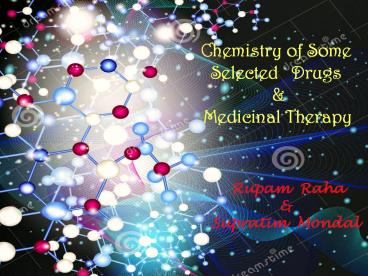Medicinal Chemistry - PowerPoint PPT Presentation
Title:
Medicinal Chemistry
Description:
Its about selected daily used medicine and medicinal therapies. – PowerPoint PPT presentation
Number of Views:961
Title: Medicinal Chemistry
1
Chemistry of Some Selected Drugs
Medicinal Therapy
Rupam Raha Supratim Mondal
2
Our Journey Contains
- Aspirin
- History
- How it Works
- Uses
- Toxic Effect
- Insulin
- How it Works
- Uses
- Chrysotherapy
- What is it?
- Working pathway
- Side Effects
- Platinum Drugs in Chemotherapy
- Working pathway
- Surprise
- Side-effects
3
Aspirin
History
1830 A Scottish physician found that extracts of
willow bark relieved symptoms of acute rheumatism.
1870 Salicin was found in willow, which
converts to Salicylic Acid in human Body .
Professor von Nencki of Basle gives Salicylic
Acid to patients with fevers and their symptoms
were relieved. However, the compound caused
severe irritation of the liningof the mouth,
gullet and stomach.
Chemists made sodium salicylate and gave that to
doctors to try on their patients. It still worked
to help reduce pain and fever and did lessen the
irritation, but tasted awful!
In 1982,Nobel Prize for medicine awarded for work
on prostaglandins and related compounds. John
Vare, who shared the prize with two Swedes,
discovered that aspirin and some other
painkillers and anti-inflammatory drugs (such as
ibuprofen) inhibit a key enzyme in the
prostaglandin synthetic pathway.
4
How Aspirin Works In Human Body
Aspirin(2-Ethanoyloxybenzenecarboxylic acid)
mainly chelate out extra Copper present in blood
stream and give it back to the copper deficient
body cells to repair the Biochemical lesions
Also numbs the pain receptors to give relief
from pain.
Aspirin inhibits a key enzyme in the
Prostaglandin Synthesis. They therefore stop your
body making Prostaglandins, some of
which stimulate pain receptors and cause
inflammation.
5
Aspirin, as Anti-platelate agent, works by
inhibiting the production of Thromboxane. Aspirin
is highly recommended for preventing the 1st
Attack.
6
Uses of Aspirin
Toxic Effect
- Relieves Pain Analgesic
- Relieves Fever- Antipyretic
- Relieves Inflammation Anti-inflammatory
- Relieves Rheumatism -Antirheumatic.
- Stomach Ulcers
- Burning throat pain
- Vomiting pain
- Dizziness
7
Insulin
Insulin is basically a Zn(II) protein and
essentially required in GLUCOSE METABOLISM.
Working Principle
In Carbohydrate Metabolism, Phosphorylation is an
essential step, but this process is prevented by
the diabetogenic hormone. Insulin, by
COMPLEXATION, keeps the GLUCOSE METABOLISM
process normal Thus the function of INSULIN is
to remove the PITUITARY FACTOR which interferes
in GLUCOSE METABOLISM
8
Structural Overview
Insulin consists of 2 POLYPEPTIDE chains, a ß
chains, linked together by di-sulphide bonds.
Firstly Preproinsulin forms in Pancreatic ß
cells undergoes maturation into active Insulin
through PROHORMONE CONVERTASES ..
9
Uses
When natural secretion of Insulin in Pancreas is
become problematic, Insulin should be
administrated INTRAMASCULARLY.. Generally Insulin
is used EXCLUSIVELY by DIABETIC patients
10
(No Transcript)
11
Chrysotherapy
Arthritis is a form of joint disorder that
involves inflammation in one or more joints, the
most common forms are OSTEOARTHRITIS and
Rheumatoid arthritis
In the treatment of, therapy using Gold drugs is
known as Chrysotherapy .
Gold salts for Rheumatoid arthritis are
administered by INTRAMASCULAR injection but also
can be administered ORALLY . 3-6 Months are
often required to observe noticeable improvement.
12
Popular Gold Drugs
- Sanocrysine
- Myochrysine
- Solganol
- AURANOFIN (SECOND GENERATION GOLD DRUG)
AURANOFIN
13
Working Principle
Gold drugs may have effects on the joint
structure through the stabilization of the
COLLAGEN by cross-links. All the evidences
indicate that Au(I) protects the SH groups of
the proteins and inhibits the formation of
di-sulphide (-S-S-) bonds which lead to
denaturation subsequent formation of
macroglobulins. Thus they decreases inflammation
and the patient gets relief..
14
Chrysotherapy
Side-Effects of
It must be mentioned that during gold therapy,
toxicity due to gold metal should be monitored .
- Chrysiasis (acute renal faliure) .
- Permanent Pigmentation of skin when exposed to
sunlight. - Ulcerations of Mouth, tongue.
15
Platinum Drugs in Chemotherapy
In mid 1960, Rosenberg his co-workers
accidentally discovered the anti-cancer activity
of Cis-platin (cis-DDP).
- Cancer is a group of diseases that are
characterized by the loss of control of the
growth, division, and spread of a group of cells
leading to a primary tumor that invades and
destroys adjacent tissues .
- Two types Benign and Malignant
- Spread through metastasis
- Administration of Chemo drugs
- by the types of Injection
- Intramuscular,
- Intravenous,
- Intra-arterial
16
Popular Drugs in Chemotherapy
- Cis-platin
- Carboplatin
- Nedaplatin
- Oxaliplatin
- Ormaplatin
17
Working Pathway
Cisplatin drug can be considered as pro-drug.
Administrating Cisplatin firstly aquated in the
inner cell media, where the concentration of
chloride ion is much lesser than outer cell
medium. After aquation the active diaqua-platinum
compound can bind with DNA strands. The main
differences between platinum Drugs can be related
to the different kinetics of activation.
Hydrolysis of cisplatin is extremely rapid,
whereas it is slower for carboplatin and
nedaplatin. The diaqua-platinum species react
with the amine groups of proteins, RNA and DNA.
The latter reaction yields platinum-DNA adducts,
which appear to be associated with anti-tumour
activity. Aquated platinum reacts preferentially
with the N-7 position of guanine and adenine and
produces cross-links between bases in the same
strand (intrastrand) or opposite strands
(interstrand). Co-ordination by the DNA bases to
the Platinum(II) centre seriously interfares the
ability of such ligated bases to undergo
Base-pairing that stabilizes the double helical
structure of DNA. Due to intrastand Crosslinking
by the adjacent bases,the DNA structure becomes
bent at the sight of Platination. This bending
gives a differtent shape of the DNA prevents
sterically the DNA Polymerase enzyme required for
replication of DNA on the course of
Cell-division.
18
(No Transcript)
19
Side-Effects
Uses
- Nephrotoxicity(Kidney Damage),
- Vomiting,
- Anorexia(loss of appetite)
- Testicular and Ovarian Tumors,
- Bronchogenic Carcinoma,
- Osteosarcoma,
- Oropharyngeal Carcinoma,
- Neuroblastoma
20
Have a Great Day Ahead...

